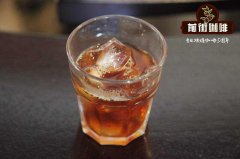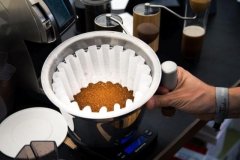[hand theory] six factors that can change the taste of coffee during brewing

Professional coffee knowledge exchange more coffee bean information please follow the coffee workshop (Wechat official account cafe_style)
Coffee is an experimental science. Coffee can not be predicted entirely by theory, but it can improve the accuracy of experiments by learning theories, narrow the possible experimental results, and turn "unpredictable" into "predictable".
There are six variables in the process of brewing coffee:
Coffee powder quantity
Water quantity
Coffee grinding degree
Water temperature
Boil time
Stir
There are many similarities between brewing coffee and cooking. Take the fat beef side stove as an example. If you put a piece of fat cow into the soup, it will soon be cooked, but if you cook 20 pieces at the same time, you have to cook it for a little longer. In addition, in a litter of small side stoves, because of the small amount of soup, it takes more time for a piece of fat cow to be cooked; on the contrary, a large pot of soup takes a piece of fat cow to be cooked quickly, because there is too much water, and the temperature is not greatly reduced because of a piece of fat cow, so it is cooked faster.
By the same token, coffee tastes sour, that is, it is not ripe enough, which is referred to as "raw" for short; when it tastes bitter, it is cooked for too long, or "cooked" for short.
How can I adjust a cup of coffee that is too sour and too raw? Is to grind the coffee a little bit, use hot water, cook it a little longer, or stir it, and so on, to make the coffee thoroughly cooked.
As for the problem that the flavor is too strong or too light, it depends on what kind of cooking tools are used. If it is a general dynamic hand filter cup, that is, when water is injected and the water comes out at the same time, the water in the cup is dynamic, and dripper such as Hario, Kono and Kalita can be counted as such, then it can be understood that "too light" means "too light" and "too thick" means "raw".
On the contrary, static tools, that is, hot water after injection will be stored in the tool and soaked in coffee, such as Clever Dripper and French Press, it can be understood that "too light" means "raw" and "too strong" means "thick".
The above set is not a flawless scientific theory, but simplifies a very complex theory to a small step that is easy to understand. If you come across any questions, you can raise them for discussion.
Here is a brief summary of how to adjust variables.
Bubble (Dripper/Espresso)
Immersion (Clever Cup/French Press)
END
Important Notice :
前街咖啡 FrontStreet Coffee has moved to new addredd:
FrontStreet Coffee Address: 315,Donghua East Road,GuangZhou
Tel:020 38364473
- Prev

How about the flavor characteristics of alpine coffee beans at high altitude? introduction to the classification characteristics of coffee beans at altitude
Professional coffee knowledge exchange more coffee bean information Please pay attention to the coffee workshop (Wechat official account cafe_style) latitude is a factor affecting the quality characteristics, altitude also affects the quality, which is a natural negative factor. Today's topic is to look at the problem of coffee cultivation in Taiwan in terms of altitude. To Taiwan
- Next

[hand-brewing theory] the principle, tools and techniques of hand-brewing coffee
Professional coffee knowledge exchange more coffee bean information please follow the coffee workshop (Wechat official account cafe_style) this time to talk about the principle of hand-brewed coffee. It can be simply understood as "scouring" and "soaking". Scouring refers to stirring with tools such as water flow or stirring sticks to strengthen the friction between coffee powder and water, making the substances in coffee powder dissolve in water; while soaking
Related
- Beginners will see the "Coffee pull flower" guide!
- What is the difference between ice blog purified milk and ordinary milk coffee?
- Why is the Philippines the largest producer of crops in Liberia?
- For coffee extraction, should the fine powder be retained?
- How does extracted espresso fill pressed powder? How much strength does it take to press the powder?
- How to make jasmine cold extract coffee? Is the jasmine + latte good?
- Will this little toy really make the coffee taste better? How does Lily Drip affect coffee extraction?
- Will the action of slapping the filter cup also affect coffee extraction?
- What's the difference between powder-to-water ratio and powder-to-liquid ratio?
- What is the Ethiopian local species? What does it have to do with Heirloom native species?

